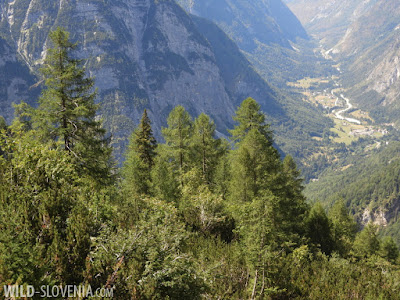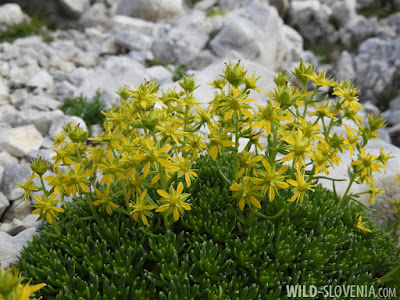
Last week we took advantage of the fine summer weather to visit, once again, some high-mountain habitats of the Slovenian Alps. Kriški podi is the name of a karstified plateau, lying at an altitude between 2000 and 2400 m.a.s.l., in the heart of the Triglav National Park. The area is most famous by its limestone pavements eroded by water and the presence of three alpine lakes. The "upper lake" or Zgornje Kriško jezero, lying at an altitude of 2154 m, is the highest lake in Slovenia. The area is rich with mountain wildlife, among which Alpine Ibex Capra ibex is the most notorious inhabitant. These animals can be seen in good numbers and usually at very close quarters on Kriški podi as they are used to the constant presence of people. Our intention was to visit the area to enjoy some general alpine wildlife, especially the flora, with no particular targets. There are just a few accesses on foot to the plateau and we decided to take the "classical" one from the Zadnjica valley (at the end of the Trenta valley). It took us about 5 hours of walking and about 1400 meters of elevation difference before we reached the mountain hut, set on the plateau at an elevation of 2050 meters. The ascent was enjoyable as we witnessed the changing vegetational belts from the mixed forests at the valley's bottom to the sub-alpine meadows and rocky world above the treeline. After exploring the area of the three lakes on the plateau, we slept one night in the mountain hut and the next day made our way down to the valley. Among mammals we observed several groups of Alpine Ibex Capra ibex & Alpine Chamois Rupicapra rupicapra, a few Marmots Marmota marmota and a Snow Vole Chionomys nivalis. Birds were thin on the ground, because of the late season, but we nevertheless managed to observe a Golden Eagle Aquila chrysaetos, a few Alpine Accentors Prunella collaris & Ring Ouzels Turdus torquatus, a Black Woodpecker Dryocopus martius and most amazingly, a flock of Bee-eaters Merops apiaster on migration over the Alps!
As it is the tradition with mountain-trekking posts, here follows a bottom-top selection of photos from the trip.
View from the Trenta valley to the mountains above Kriški podi.
The long walk uphill along the Beli potok canyon.
The mountain hut (Pogačnikov dom) is just visible on the edge of the plateau.
On some rocks along the path we were greeted by the beautiful Tufted Horned Rampion Physoplexis comosa - not in bloom anymore, but still looking amazing! This is one of the few sites where this rare species grows in Slovenia.
Blue-spot Hairstreak Satyrium spini on Lax Cinquefoil Potentilla caulescens.
Silver-washed Fritillary Argynnis paphia of the dark form valesina (quite common).
View down to the Trenta valley with mount Bavški Grintavec (2347 m) dominating the valley.
Rocky slopes to Kriški podi.
Einsel's Columbine Aquilegia einseleana was common along the way.
A few bunches of amazingly-fragrant Sternberg's Pinks Dianthus sternbergii greeted us as we made our way out of the forest and into a limestone scree in the sub-alpine belt.
A look south-eastwards to mount Kanjavec (2569 m) in the Triglav mountain chain.
Making our way through the belt of Larch Larix decidua and Mountain Pine Pinus mugo that represent the natural upper treeline in the Alps.
Rocky slopes along the way, covered with Mountain Pine Pinus mugo and the odd Norway Spruce Picea abies.
Shepherd's Fritillary Boloria pales on Glossy Scabious Scabiosa lucida.
Reached the rocky world above the treeline...
...and the first rock-specialist plants appeared: Alpine Toadflax Linaria alpina.
Some hours after the start and another look down into the Trenta valley.
Mount Razor (2601 m) is the highest and most prominent peak dominating the Kriški podi plateau.
Spodnje Kriško jezero (Lower Križ lake).
Pogačnikov dom na Kriških podih (2050 m) - a large mountain hut, almost like a high-altitude hotel.
Zgornje Kriško jezero (Upper Križ lake) - at 2154 meters is the highest-lying lake in Slovenia.
An immature Golden Eagle Aquila chrysaetos drifted past as the local Alpine Marmots Marmota marmota screamed loud alarm calls.
Mount Stenar (2501 m) above the Kriški podi plateau.
Signs of rainwater erosion on the limestone pavements of Kriški podi.
Fairy's Thimble Campanula cochleariifolia growing quite commonly among rocks.
Zois' Bellflower Campanula zoysii was still in good bloom above 2000 meters. However, note that most flowers have a hole at the side of the "bell". This is the sign of a theft: a bumblebee stole nectar from the flower, without pollinating it.
Yellow Saxifrage Saxifraga aizoides
Pink Cinquefoil Potentilla nitida still doing well above 2000 m.a.s.l.
Lower down the blooming was already over.
Edelweiss Leontopodium alpinum
Pyrenean Whitlow Grass Petrocallis pyrenaica
Alpine Bilberry Vaccinium gaultherioides
This showy female Alpine Ibex Capra ibex was just one of the +10 we saw grazing around the plateau.
Late-afternoon view from the mountain hut.
View from our bedroom's window with the Middle and Upper Križ lakes
(Srednje & Zgornje Kriško jezero).
The next morning an amazing alpine sunrise greeted us and we enjoy views over mount Krn in the distance.
An early walk around the plateau produced a group of Alpine Chamois Rupicapra rupicapra - another ungulate sharing the alpine grazing grounds with the Ibex.
Breakfast with a view.
Another look at Pogačnikov dom with two prominent mountains in the back:
Razor to the right and Planja to the left.
And now the long way back to the valley.
As we reached the Zadnjica valley we refreshed our feet in the ice-cold Krajcarica stream and a surprise greeted us nearby...
...a Zois' Bellflower Campanula zoysii on a rock by the stream and most amazingly, still in flower, despite the low altitude (about 600 m)! Obviously the stream's cold water creates a perfect high-altitude microclimate for this species that has been washed down from its usual haunts in the mountain heights.
Nearby a young Dipper Cinclus cinclus was bathing in the stream too.
And to round up the post, here's a Rosalia Longicorn Rosalia alpina, sadly a dead specimen found in the Juliana Alpine Botanical Garden in the Trenta valley by the garden's staff.
Hope to see a live one sometime in the future!
Find out more about the wildlife of the Slovenian mountains on our website:
Mountains-Alps












































































